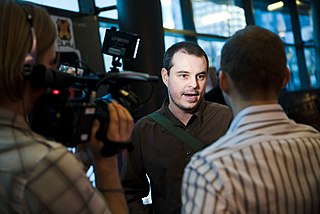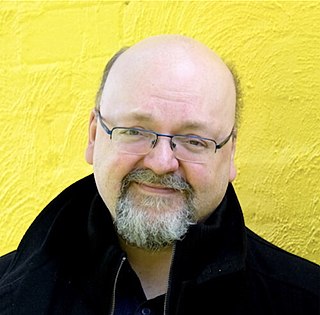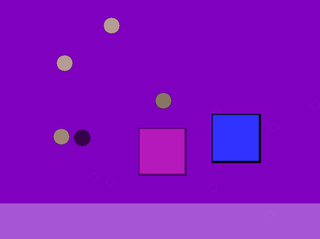A game programmer is a software engineer, programmer, or computer scientist who primarily develops codebases for video games or related software, such as game development tools. Game programming has many specialized disciplines, all of which fall under the umbrella term of "game programmer". A game programmer should not be confused with a game designer, who works on game design.
Video game design is the process of designing the content and rules of video games in the pre-production stage and designing the gameplay, environment, storyline and characters in the production stage. Some common video game design subdisciplines are world design, level design, system design, content design, and user interface design. Within the video game industry, video game design is usually just referred to as "game design", which is a more general term elsewhere.
Gonzalo Frasca is a game designer and academic researcher focusing on serious and political videogames. His blog, Ludology.org, was cited by NBC News as a popular designation for academic researchers studying video games. For many years, Frasca also co-published Watercoolergames with Ian Bogost, a blog about serious games.
Video game development is the process of creating a video game. It is a multidisciplinary practice, involving programming, design, art, audio, user interface, and writing. Each of those may be made up of more specialized skills; art includes 3D modeling of objects, character modeling, animation, visual effects, and so on. Development is supported by project management, production, and quality assurance. Teams can be many hundreds of people, a small group, or a even a single person.
Filmmaking or film production is the process by which a motion picture is produced. Filmmaking involves a number of complex and discrete stages, beginning with an initial story, idea, or commission. Production then continues through screenwriting, casting, pre-production, shooting, sound recording, post-production, and screening the finished product before an audience, which may result in a film release and exhibition. The process is nonlinear, as the director typically shoots the script out of sequence, repeats shots as needed, and puts them together through editing later. Filmmaking occurs in a variety of economic, social, and political contexts around the world, and uses a variety of technologies and cinematic techniques to make theatrical films, episodic films for television and streaming platforms, music videos, and promotional and educations films.

Far Cry 2 is a 2008 first-person shooter developed by Ubisoft Montreal and published by Ubisoft for Microsoft Windows, PlayStation 3 and Xbox 360. A top-down shooter version for mobile phones was developed and published by Gameloft. It is the second mainline entry in the Far Cry series. Set in a fictional African country engulfed in civil war, the storyline follows a mercenary who is assigned to kill the Jackal, a weapons dealer inflaming the conflict. The player navigates the open world, completing missions for factions and allies called Buddies while managing their health and equipment. A competitive multiplayer mode allows players to fight in teams or as individuals.
A narrative designer, or interactive narrative designer, is a role in contemporary video game development, the focus of which is to design the narrative elements of a game based on how players interact with its story, which differentiates it from video game writing.
Brian Mitsoda is an American video game designer and writer best known for his work on the 2004 game Vampire: The Masquerade – Bloodlines. He is the founder of DoubleBear Productions.

Clint Hocking is a Canadian video game designer and director. He has primarily worked at the Canadian divisions of Ubisoft, where he developed three titles, and briefly worked at LucasArts, Valve, and Amazon Game Studios.

Dragon Age II is a 2011 action role-playing video game developed by BioWare and published by Electronic Arts (EA). It is the second major game in the Dragon Age series and the successor to Dragon Age: Origins (2009). Set in the world of Thedas, players assume the role of Hawke, a human mage, rogue, or warrior who arrives in the city of Kirkwall as a lowly refugee, and becomes its legendary champion over a turbulent decade of political and social conflict. In the game, players explore and engage in combat from a third-person perspective. Players encounter various companions, who play major roles in the game's plot and gameplay. Depending on players' decisions and dialogue, a companion will either recognize Hawke as a friend or a rival.

Ludonarrative dissonance is the conflict between a video game's narrative told through the non-interactive elements and the narrative told through the gameplay. Ludonarrative, a compound portmanteau of ludology and narrative, refers to the intersection in a video game of ludic elements (gameplay) and narrative elements. The term was coined by game designer Clint Hocking in 2007 in a blog post.

David Gaider is a Canadian narrative designer and writer. He was the lead writer and creator of the setting for the role-playing video game series Dragon Age.
The Critical Path Project is a video archive of interviews with video game designers and developers.

Chris Remo is an American video game designer, composer, writer, podcaster, and former journalist.

Procedural rhetoric or simulation rhetoric is a rhetorical concept that explains how people learn through the authorship of rules and processes. The theory argues that games can make strong claims about how the world works—not simply through words or visuals but through the processes they embody and models they construct. The term was first coined by Ian Bogost in his 2007 book Persuasive Games: The Expressive Power of Videogames.

The Marriage is an experimental art game created by Rod Humble and released for Microsoft Windows in March 2007. Humble set out to explore the forms of artistic expression unique to video games, leading him to express his feelings associated with marriage by relying primarily on game mechanics rather than on traditional storytelling, audio, or video elements. The game uses only simple colored shapes that the player interacts with using a mouse. The player's actions cause pink and blue squares to increase or decrease in both size and opacity, representing the balance of personal needs in a relationship.

Cremisius "Krem" Aclassi is a fictional character in the 2014 video game Dragon Age: Inquisition. He is a former soldier in the Tevinter Imperium's military forces, and is currently a member of the Bull's Chargers, a mercenary company led by the Iron Bull. He was created and written by Patrick Weekes. Canadian-American voice actress Jennifer Hale voiced Krem in Inquisition.

Dragon Age: The Silent Grove is a six-issue heroic fantasy comic book limited series set in the Dragon Age universe. The first in a series of Dragon Age visual media to be published by Dark Horse Comics, it was originally an exclusive digital release between February and May 2012. The series was primarily written by David Gaider, with Alexander Freed as scriptwriter and artwork by Chad Hardin.
In video games, narrative has been of varying significance and importance since the beginning of the medium. Though early games did not feature stories as a focus, technological advances have afforded developers the freedom to make narrative a major element. Adding story was not typically feasible in the earliest video games due to technological limitations of the time, but technological advances made since then have enabled a greater focus on stories through cutscenes and voiced dialogue.
Comedy in video games refers to the prevalence of comedy within the medium of video games. While some critics and designers believe the genre of comedic video games suffers from a lack of development, it has been argued that incidental comedy in video games is rather common, often coming in the form of "ludo-comedic consonance", an affinity between narrative and gameplay that reinforces comedy in a similar manner to how ludonarrative dissonance is a disconnect between narrative and gameplay. Both comedy and video games have historically had difficulty gaining recognition and status from academic institutions, and have been called trivial by critics. They were later both determined to be worthy of study, as scholars accepted that goal-oriented gameplay was not the sole means to experience a video game. Nevertheless, it remains common for serious games to be thought of as more artistic, while the artistry necessary to create comedy in a video game has been overlooked.









